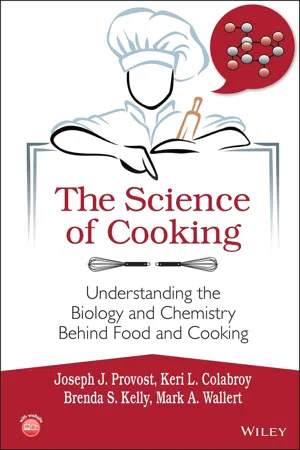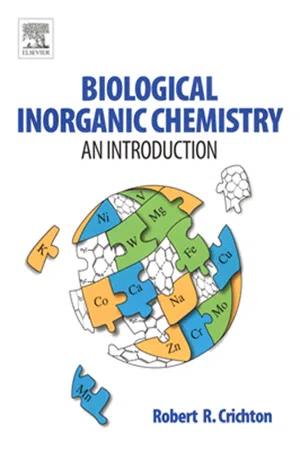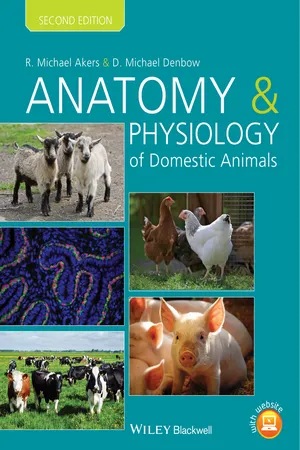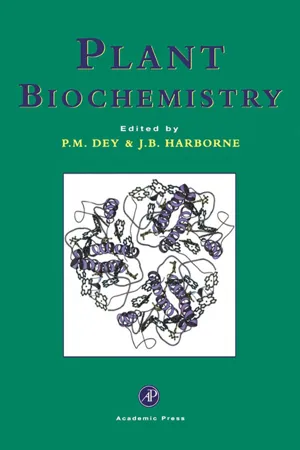Biological Sciences
Pyruvate Oxidation
Pyruvate oxidation is a crucial step in cellular respiration where pyruvate, a product of glycolysis, is converted into acetyl-CoA. This process takes place in the mitochondria and involves the removal of a carbon dioxide molecule and the transfer of electrons to NAD+ to form NADH. The resulting acetyl-CoA then enters the citric acid cycle to further generate ATP.
Written by Perlego with AI-assistance
Related key terms
Related key terms
1 of 4
Related key terms
1 of 3
7 Key excerpts on "Pyruvate Oxidation"
- eBook - ePub
- Pascal Leclair(Author)
- 2023(Publication Date)
- CRC Press(Publisher)
9 The Energy of Cells Part II Oxidative PhosphorylationDOI: 10.1201/9781003379058-9We saw in Chapter 5 that foodstuff initially gets broken down in the glycolytic pathway, quickly yielding a small burst of energy usable by cells. During anaerobic respiration, which includes the process of fermentation, this pathway results in the accumulation of lactic acid in mammals or ethanol and CO2 in yeast and other fermenting organisms. However, if oxygen is available, the end-product of glycolysis, the three-carbon molecule, pyruvic acid, is converted to a high-energy compound, acetyl-CoA, which then combines with oxaloacetate to form citric acid, the first molecule of the Krebs cycle. The Krebs cycle is a series of redox reactions that create FADH2 and NADH as by-products and its end-product, oxaloacetate, is recycled to form citrate in a new cycle. The end result of glycolysis and the Krebs cycle is the net synthesis of ATP, whose terminal phosphates can be used as a signaling tag (discussed in Chapters 12 and 13 ) or as a high-energy bond to enable cellular reactions. In this chapter, we discuss the experiments which allowed the elucidation of the mechanism of oxidative phosphorylation, that is, how FADH2 and NADH donate electrons to the electron transfer chain of mitochondria—the powerhouse of the cell and the main site of ATP synthesis—which creates a H+ gradient across the mitochondrial membrane that fuels the synthesis of ATP.In 1932, Otto Warburg and W. Christian identified a new class of molecules involved in the transfer of hydrogen ions. Warburg had always been suspicious about the reactions occurring in Thunberg tubes and questioned whether they were physiologically relevant.1 However, a visit to a colleague’s laboratory in the U.S. was to change his mind. A colleague performed some experiments on red blood cells for him which showed that methylene blue was reduced in the metabolism of glucose to CO2 and pyruvate. Warburg was intrigued by this phenomenon and, therefore, began an investigation of the chemistry of methylene blue.1 As such, he found that incubation of ATP, glucose-6-phosphate (the first intermediate of glycolysis), and methylene blue with yeast cell extracts led to an O2 uptake, and dialysis of the extracts revealed that two components were required for this hydrogen-transferring process: a heat-labile enzyme and a heat-stable co-enzyme.1 The enzyme component was further fractionated into two components, one of which had a yellow color when oxidized and became clear when reduced—this molecule was appropriately named “yellow enzyme”.2 This substance, which Warburg and Christian succeeded in isolating a few years later, was later called lumiflavin and was determined to be part of a greater family of molecules called flavoproteins which are used as carriers of hydrogen (Figure 9.1 - eBook - ePub
- Rodney P. Anderson, Linda Young(Authors)
- 2016(Publication Date)
- Wiley(Publisher)
+ consumed. When glucose is completely oxidized to water and carbon dioxide in the presence of oxygen, its electrons reduce activated carriers that ultimately participate in the redox reactions of chemiosmosis. The end result of this metabolic pathway is the generation of 38 molecules of ATP from a single glucose—a 19-fold increase in energy production over fermentation pathways. In eukaryotic cells, these reactions occur in the mitochondrial matrix and cristae. In prokaryotic cells, oxidative phosphorylation takes place in the cytoplasm and on infoldings of the plasma membrane.Pyruvate Oxidation and the Citric Acid Cycle
The first step in this aerobic pathway is Pyruvate Oxidation. Pyruvate dehydrogenase is a large enzyme complex that accomplishes this and the two steps that follow (Figure 7.9 ). The pyruvate generated by glycolysis loses a carboxyl, or acid, functional group( — COOH )forming acetate and the by-product, carbon dioxide (step 1). During this oxidation,NAD+is reduced to NADH, storing the energy of the electrons for later use (step 2). Finally, coenzyme A (CoA) is added to acetate to form acetyl CoA (step 3 - eBook - ePub
The Science of Cooking
Understanding the Biology and Chemistry Behind Food and Cooking
- Joseph J. Provost, Keri L. Colabroy, Brenda S. Kelly, Mark A. Wallert(Authors)
- 2016(Publication Date)
- Wiley(Publisher)
2 , producing the maximum amount of ATP. However if the oxygen levels fall due to exercise or other factors, anaerobic metabolism of pyruvate shifts to produce lactate. This has an important impact in meat before harvest.To review, in the presence of oxygen, pyruvate undergoes further oxidation to the molecule acetyl-CoA, which can be completely oxidized to CO2 . This process comprises aerobic respiration, which generates a large amount of ATP, H2 O, and CO2 . Under anaerobic conditions or conditions where fermentation is favored, the energy needs of the organism are met by the modest ATP yield of glycolysis as no additional ATP is generated in the further breakdown of pyruvate. In these cases, however, an organism still requires a means to regenerate NAD+ so that glycolysis can continue as the organism’s primary means to make ATP. The metabolic processes that occur to regenerate NAD+ that do not require oxygen are called fermentation processes. As we have begun to learn, fermentation is very important in cooking and foods such as yogurt, cheese, beer, wine, soy sauce, and pepperoni (Box 4.2 ).BOX 4.2 FERMENTATION VERSUS GLYCOLYSIS
Let’s consider the definition of glycolysis and fermentation. Glycolysis, as you’ve learned, is the oxidation of glucose to pyruvate. Fermentation is a broader term that includes glycolysis but includes whatever pathway is used to oxidize NAD+ back to NADH in anaerobic conditions. Thus fermentation will include glucose to pyruvate and then the continued metabolism to lactate, ethanol, acetate, carbon dioxide, or other compounds depending on the organism and conditions. Fermentation has a more loose historical definition that involves ethanol in wine and beer. Therefore fermentation is a combination of different metabolisms to produce ATP from glucose and regenerate NAD+ from NADH.4.6 AEROBIC RESPIRATION: THE TRICARBOXYLIC ACID CYCLE AND OXIDATIVE PHOSPHORYLATION
In the presence of oxygen, the pyruvate generated in glycolysis is fully oxidized to CO2 , the energy of which is used to make ATP. Three different pathways are necessary to carry out this complete oxidation. The pyruvate is first processed by a large enzyme complex called the pyruvate dehydrogenase (PDH) complex. The PDH complex, as its name implies, oxidizes and decarboxylates the pyruvate into two molecules: a two-carbon molecule called acetyl-CoA and CO2 (Fig. 4.13 ). The acetyl-CoA can then enter the second pathway, called the tricarboxylic acid (TCA) cycle, which allows for further oxidation of the molecule (Fig. 4.14 - No longer available |Learn more
MCAT Biochemistry Review 2024-2025
Online + Book
- (Author)
- 2023(Publication Date)
- Kaplan Test Prep(Publisher)
MCAT Biochemistry Review—don’t they produce energy without oxygen? While glycolysis does not depend on oxygen, it only yields a net 2 ATP per molecule of glucose, which is not nearly enough to maintain the body’s energy requirements. This brings us to two of the most tested topics on the MCAT: the citric acid cycle and oxidative phosphorylation.In this chapter, we’ll take a close look at what’s gained when the products of glycolysis and other derivatives of metabolic pathways enter the citric acid cycle. We’ll also look at how this process is regulated with regard to the substrates, products, and reactions involved. Lastly, we’ll observe what happens when this cycle’s products undergo oxidative phosphorylation, with particular emphasis on how the electron transport chain facilitates the process and the ATP that is yielded.10.1 Acetyl-CoA
LEARNING OBJECTIVES
After Chapter 10.1, you will be able to:- Detail four potential energy sources for the synthesis of acetyl-CoA
- Identify the major inputs and outputs through the pyruvate dehydrogenase complex
The citric acid cycle, also called the Krebs cycle or the tricarboxylic acid (TCA) cycle, occurs in the mitochondria. The main function of this cycle is the oxidation of acetyl-CoA to CO2 and H2 O. In addition, the cycle produces the high-energy electron-carrying molecules NADH and FADH2 . Acetyl-CoA can be obtained from the metabolism of carbohydrates, fatty acids, and amino acids, making it a key molecule in the crossroads of many metabolic pathways and a highly testable compound.Methods of Forming Acetyl-CoA
Recall from Chapter 9 of MCAT Biochemistry Review that after glucose undergoes glycolysis, its product, pyruvate, enters the mitochondrion via active transport and is oxidized and decarboxylated. These reactions are catalyzed by a multienzyme complex called the pyruvate dehydrogenase complex, which is located in the mitochondrial matrix. As we take a deeper look at the enzymes that make up this complex, as well as the substrates and products of their reactions, it is helpful to follow the carbons in the molecules. For example, the three-carbon pyruvate is cleaved into a two-carbon acetyl group and carbon dioxide. This reaction is irreversible, which explains why glucose cannot be formed directly from acetyl-CoA. In mammals, pyruvate dehydrogenase complex is made up of five enzymes: pyruvate dehydrogenase (PDH), dihydrolipoyl transacetylase, dihydrolipoyl dehydrogenase, pyruvate dehydrogenase kinase, and pyruvate dehydrogenase phosphatase. While the first three work in concert to convert pyruvate to acetyl-CoA, the latter two regulate the actions of PDH. Figure 10.1 shows the overall reaction for the conversion of pyruvate to acetyl-CoA. The reaction is exergonic - eBook - ePub
Biological Inorganic Chemistry
An Introduction
- Robert R. Crichton(Author)
- 2007(Publication Date)
- Elsevier Science(Publisher)
Figure 5.9 ) complex macromolecules, such as proteins and storage polysaccharides (glycogen in animals, starch in plants) and fat stores in the form of triglycerides, are first hydrolysed to their basic components—amino acids, monosaccharides, essentially glucose, and glycerol plus fatty acids, respectively. In the second phase, these molecules are transformed into a series of molecules that will feed the final and central core of catabolism, namely, the tricarboxylic acid cycle. In the case of glucose, this is converted into pyruvate by the glycolysis pathway, which is described in greater detail below. Of the 20 amino acids found in proteins, all must first be divested of their amino group, which is usually converted to ammonium ions (which in many organisms must be detoxified by conversion to urea). The resulting carbon skeletons are then transformed either into pyruvate, acetyl CoA or one of the constituents of the tricarboxylic acid cycle. In the case of triglycerides, glycerol can enter the glycolytic pathway, while the long-chain fatty acids are transformed by β-oxidation into acetyl CoA. The oxidation of amino acids and fatty acids is centralized within the mitochondria, where all the enzymes involved in the tricarboxylic acid cycle are also localized.Figure 5.9 An overview of catabolism.As was indicated in Equation (5.1) , in addition to CO2 , the other final product of glucose oxidation is H2 O, which is produced by the four-electron reduction of dioxygen together with 4H+ to give two molecules of water. The reducing equivalents come from the dehydrogenase reactions of catabolism in the form of NADH and FADH2 . Their electrons are then transferred through a series of electron acceptors to the terminal oxidase of this so-called respiratory chain, cytochrome c oxidase. As the electrons pass down this electron transport chain, they generate a proton gradient that, as we will see shortly, is used to drive the proton translocating ATP synthase. This aspect of mitochondrial function is usually referred to as oxidative phosphorylation.We will return to an overview of anabolic pathways shortly, but first we want to examine in more detail the two important catabolic pathways, glycolysis and the tricarboxylic acid cycle.SELECTED CASE STUDIES: GLYCOLYSIS AND THE TRICARBOXYLIC ACID CYCLE
Glycolysis4 is an almost universal pathway for glucose catabolism, widely distributed in living organisms, which converts glucose into two molecules of pyruvate with the net production of two molecules of ATP and two molecules of NADH (of which more later). It consists of a sequence of ten reactions (Figure 5.10 ), the first five of which transform one molecule of glucose into two molecules of triose phosphate, and consume two molecules of ATP. The five subsequent reactions transform the two molecules of triose phosphate, as glyceraldehyde-3-phosphate, into two molecules of pyruvate with production of four molecules of ATP and two of NADH. Of the ten reactions, six are phosphoryl transfers (1,3,6,7,8,10), two are sugar isomerizations (2,5), one is an aldol cleavage (4), one is an NAD+ - eBook - ePub
- R. Michael Akers, D. Michael Denbow(Authors)
- 2013(Publication Date)
- Wiley-Blackwell(Publisher)
Figure 3.4 . At this point, it is worth remembering the significance of glycolysis. This pathway allows the conversion of the nutrient glucose into molecules that can then be shuttled into the mitochondria for use in the process of oxidative phosphorylation. However, as we indicated earlier, oxidative phosphorylation (simply the production of ATP linked to a series of oxidation–reduction reactions) requires oxygen. In addition to preparing molecules for entrance into the mitochondria, a small amount of ATP is produced during the glycolysis reactions. In contrast with mitochondrial activity, this occurs via substrate-level phosphorylation. As you will see, the amount of ATP made in this manner is very small compared with that which occurs with the complete catabolism of the glucose (glycolysis reactions + mitochondrial activity), but it is nonetheless essential. This is because production of ATP via glycolysis alone can occur in the absence of oxygen. For this reason, it is called anaerobic respiration.Table 3.2.Common terms associated with the metabolism of carbohydrates.Term Definition Glycolysis Anaerobic oxidation of a molecule of glucose via 10 enzymatic reactions to produce two molecules of pyruvate. The reactions occur in the cytoplasm. Glycogenolysis The breakdown of glycogen to produce glucose for utilization in the glycolysis catabolic pathway. Glycogenesis Synthesis of glycogen from glucose. Gluconeogenesis The formation of glucose from noncarbohydrate substrates. Important in times of stress, makes glucose available from nonessential amino acids. Critical in ruminants due to fermentation of dietary carbohydrates. Fig. 3.3.Chemical steps and intermediates in glycolysis are illustrated.Fig. 3.4. - eBook - ePub
- P. M. Dey, J. B. Harborne(Authors)
- 1997(Publication Date)
- Academic Press(Publisher)
This chapter refers to the use of monosaccharides as energy reserves in plants. Although a large plethora of substrates such as proteins and lipids can be oxidized in plants, respiration tends to be dominated by carbohydrate oxidation through the glycolytic pathway and the tricarboxylic acid (TCA) cycle. Carbohydrate is converted into pyruvate and malate by two major pathways, glycolysis and the oxidative pentose phosphate pathway. The primary roles of the pentose phosphate pathway, for example, to generate NADH for use in biosynthetic reactions and to provide ribose-5-phosphate for nucleotide synthesis and erythrose-4-phosphate for the synthesis of shikimic acid derivatives are discussed. We also refer to the regulation of the pentose phosphate pathway and interconversions between the glycolytic pathway. Lipids are established storage reserves in plants. During germination, lipid is converted into sugar by fatty acid β-oxidation, the glyoxylate cycle and gluconeogenesis. Gluconeogenesis and its regulation are discussed in this chapter.Under aerobic conditions, pyruvate is oxidized still further to CO2 by the TCA cycle generating NADH/FADH2 equivalents. Its regulation and physiological roles are discussed. Both NADH and FADH2 are oxidized by O2 in the mitochondrial electron transport chain which is coupled to ADP phosphorylation. The structural configuration of the electron transport chain along with hypothesis accounting for the proposed coupling mechanism between electron transport and ATP synthesis are discussed.This chapter highlights the major pathways of carbohydrate metabolism that play important roles in plant physiology such as improved crop yield.3.2 GLYCOLYSIS
Glycolysis or the Embden–Meyerhof–Parnas pathway, first recognized in yeast cells and mammalian muscle tissue, is now one of the best established pathways of carbohydrate metabolism in plants (Fig. 3.1 ). It is one of two major pathways by which carbohydrate is degraded ultimately to CO2 , the other being the pentose phosphate pathway (section 3.3 ). These pathways are catabolic and are concerned with converting the carbon in reduced form, which has been captured from the atmosphere by photosynthesis, into an oxidized form with the release of energy. Glycolysis is a key metabolic feature of the respiratory process of the plant cell (section 3.4 ) and is particularly important in the cells of germinating seedlings and in non-photosynthetic cells of the mature plant.Figure 3.1 Reactions of glycolysis. Enzymes of the glycolytic sequence are: (1) hexose-P isomerase; (2) phosphofructokinase; (3) aldolase; (4) triose-P isomerase; (5) glyceraldehyde-3-P dehydrogenase; (6) glycerate-3-P kinase; (7) glycerate-P mutase; (8) enolase; (9) pyruvate kinase.3.2.1 The pathway
The starting material for glycolysis is glucose-6-phosphate, which is available from the phosphorylation of glucose, catalyzed by a hexokinase. This reaction requires one molecule of ATP and the divalent metal cation Mg2+ , which forms a complex with ATP before it participates in the reaction. The phosphorylation of glucose at the 6-position is essentially irreversible, and the change in standard free energy ΔG°′ is −16.7 kj mol−1
Index pages curate the most relevant extracts from our library of academic textbooks. They’ve been created using an in-house natural language model (NLM), each adding context and meaning to key research topics.
Explore more topic indexes
Explore more topic indexes
1 of 6
Explore more topic indexes
1 of 4






